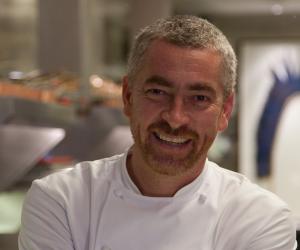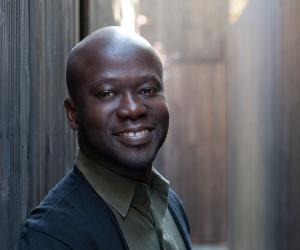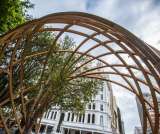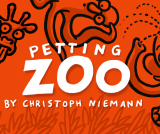
South Africa’s had no shortage of hard news to start the year with, but taking a break from it all, KATHY BERMAN found her way into the Design Indaba – and concluded that design really could change the lives of all South Africans, if we’re only open to the possibilities.
The Design Indaba 2013 is now in its 18th year. And while it could be an exclusive talk-shop for advertising and design specialists, focusing on type-faces, style and computer-generated imagery, this high-point in our local, and global, design calendars is so much more than that.
Stretching into almost a month of film, music, and live creative events, the Design Indaba signals the morphing of art, science, innovation, development, and creativity.
Built around the central three-day conference, which brings the most significant global thinkers (and doers) in creativity innovation and science to our shores, the Design Indaba never fails to inspire, astound – and even intimidate. As co-facilitator, Khaya Dlanga, joked on day one, “You can’t help but leave here feeling SO USELESS!”
But that is not the intention: Multi-disciplinary visionary Daan Roosegaarde, whose Studio Roosegaarde is committed to exploring the juncture between art, design, technology and function noted: “There is always a George Orwell story where technology will make us less human. And there is the Leonardo da Vinci model that elevates us.”
So while typography inevitably did feature in this year’s conference, it was the off-the-wall quirky, and sheer brilliant moments of invention and innovation (what Design Indaba founder Ravi Naidoo, characterises as a “laboratory for change”) that captivated the 3,000 people who attended the Cape Town conference and conference simulcasts that took place in three national centres this year.
The speakers included the witty and laconic legends of the graphic design and advertising industry such as Seymour Chwast, Paula Scher, Steven Heller and Louise Fili, whose careers in design commenced in the grand days of NY (protest) 60s design, when craftsmanship was consigned to lead pencils and colour wash, and encompassed the moral outrage of an anti-war generation.
The final day was slated to feature advertising legend, Sir John Hegarty, and acclaimed British architect David Adjaye, OBE.
Filtered in between was a new digital generation which, in the words of multi-media maestro Daan Roosegaarde “no longer operates in isolation in an attic” but is rather part of a “great team working together across continents and cyberspace – scientists, engineers, artists, musicians, designers”, steeped in the art of technology.
Creative collaboration
Studio Roosegaarde takes this collaboration well past the collaboration of social media and open platforms – although Daan Roosegaarde delighted the audience with a prototype fibre that becomes more transparent the more excited the wearer becomes – what he so viscerally called “digital-goosebumps”. Their contributions to science and development included sustainable road lighting and markers. As Roosegaarde noted with a touch of irony: “Annually billions are spent on cars – updating, improving, streamlining, computerising them. But the roads that they travel on [which hack through our landscapes] are connected to an innovative technology that stretches back to the Middle Ages”. And so Studio Roosegaarde invented sustainable road markings: photo-luminescent (glow-in-the-dark), they charge during the day and emit light at night. Their road surface paints change colour with temperature changes, notifying the drivers of hazardous conditions. And a strip of road that charges electric cars as they drive over it – in prototype in Holland is due to go national this year. “A project like this would not have happened when there was money.”
Not that money seems to be the driver for many of the speakers. Their currency instead seems to be passion – pure passion for pure art, pure science and pure invention. And humour – piles of it. Creative whimsy
Alexander Chen, a self confessed Brooklyn geek who works at Google Creative Labs, was inspired by the visual lines of the NYC subway map. He created an animated cyber-Google from the patterns of the map: lines that when “crossed” by a dancing dot, started strumming – witness his J.S. Bach - Cello Suite No. 1 – Prelude and Les Paul Google doodle.
And talking music, and taking absurd to a whole new level, the work of Masashi Kawamura, founder of PARTY, and his all-male design team with their Dancing Sperms, is an internet legend. A video of genuine, “hand-made” sperms leaping under a telescope – can be customised to your favorite vimeo track. Yes, real sperms dancing to Lady Gaga’s ‘Born this Way’! (See the making of the movie.)
From the guy who created the first pop-up shops (a temporary showroom for Camper that has been rolled out to 2,000 permanent shops globally), Marti Guixé’s has created a satirical “free-standing lollipop” - atop a tripod stick. His irony extended to exhibition openings where he felt the urge to spare attendees the inconvenience of viewing art, nibbling canapés, and talking, while balancing a full glass on an open palm: So the Gin and Tonic Fog was invented from an agricultural machine that sprayed molecules in the air. This would have complemented architect Asif Khan’s purely aesthetic cloud machine quite nicely.
But it wasn’t all aesthetic and frivolous: From designer Ben Terrett came a unified website interface for the UK government services, uk.gov - over 2,000 of them, now neatly codified and fast-functioning.
Humanising our lived environment
But the truly moving and memorable moments of the Design Indaba, where so many lessons for South Africa can be extrapolated, are those projects where developing worlds, and developed ones, collide in service of our common humanity. Humanising our built environment is a constant theme for designers and activists who are intent on creating work that strives to elevate the planet and its hapless inhabitants to a higher lived plane – some of it purely cerebral and entertaining, others more measurably sustainable
For the young designer slot, Pecha Kucha, design school graduates Howard Chambers and Bland Hoke are responsible for pop-up parks and pause-centres in the middle of New York City, which they attach to scaffolding walkways that traditionally provide safety for pedestrians during construction work. The team of citysoftwalks.com created temporary functional tabletops and chairs – and the people of the city just sat down and reclaimed their space in the city – occupying Wall Street at chair level.
More substantial was the work of architect Asif Khan, whose colourful spandex shade awnings extended the deprived metal-box structures of Brazilian favelas into gentler, more human shady environments.
Conscious of how dehumanising our accepted spaces and urban settlements have become, Jeanne van Jeeswijk moves from community to community working with them to “upgrade” their lived environments.
And adapting the broken urban landscapes of war to a more real imagery, was the poignant commentary in graphic representations of the victims of war by another design school graduate, Wael Marcos, from Lebanon, who examined the depiction of refugees and war victims in materials produced the UN, MSF and other NGOs, and was intent on preserving the dignity and reality of such victims - not treating them as “specimens” represented in “conventional design tropes”.
Synthetic aesthetics – and food
Taking the conference back into the esoteric conjunction between art, science, and culture and reminding us of where we could land up, was “exported” South African Alexandra Daisy Ginsberg, design fellow on Synthetic Aesthetics, whose work is based on the fundamental thought: how, given the opportunity, we might design nature – with lessons learnt through de-constructing and re-constructing natural and man-made objects. One of her least appealing projects is to mimic the growth of bacteria on smelly cheese, and to construct, with her fellow scientists, cheese from bacteria produced on humans – feet and underarm cheese! Preceding that was the elite award from MIT for advancing human genetics in the International Genetically Engineered Machine competition.
Thankfully the wonder of food – design; essential creation and the interaction of heat and food processing on living “ingredients” – reached a far more spiritual tone under the nuanced touch of compassionate and committed São Paulo-based chef, Alex Atala, who shocked his audience with the statistic that only one eighth of a cow is used in producing your average beef dish.
For those carnivores still reeling under the revelation that what they thought was beef is actually horse, or water buffalo, this must have come as a provocative thought. A huge deal more welcoming than the alternative of human cheese.
David adjaye obe: master of architectural form
And so to the utterly elevating, intimate, articulate and passionate talk by architectural legend, British-Ghanaian David Adjaye OBE: Eloquent, and gracious in his generous sharing of his knowledge and design principles, and the intimacy with which he walked us through some of his most exciting projects one couldn’t help but pinch oneself and wonder whether this was indeed Cape Town, Dorothy. It was.
Going local and radical
And playing liberally with art, fashion, frivolity and absurdity, examining accepted fashion conventions, is another local, Leanie van der Vyver, who, for her thesis, re-built the high-heel shoe at increasingly ludicrous angles [echoing famed South African performance artist Steven Cohen]. The absurd angle leads to an extreme and gross distortion of body posture in service of beauty.
And in work that is committed to the interplay of culture, convention, leveraging his pliable body and vestments as his métier, is the globally celebrated Standard Bank Young Artist Award winner Nicholas Hlobo. During a riveting performance and video piece reflecting on his own prodigious and varied oeuvre, and its roots in his Xhosa upbringing, as he dons a hand-hewn hooded garment. Hiding his face behind this freshly crafted cultural disguise, he notes: “Being a South African, there is an invisible backpack that follows you - sometimes it is invisible, sometimes it’s not.”
Which brings us full circle – to bags and clothes, and jewels, and furnishing and innovative design – intrinsically African – or South African - in style, concept and vibrant, clashing colour and flexible forms.
Design Indaba Expo: brilliant South African creativity
While conference attendees revel in global brain-food from international icons, (almost like a Cape-based TED convention), Expo visitors indulged in overloads of local eye-candy and craftsmanship during the decadent four-day Expo, in what has become the primary showcase for our national inspired collective creative sensibility.
In an invited exhibit that looked as if it had been curated by local popular cultural manipulator Adam Levin, futurist icon Li Edelkoort curated the central thematic exhibit: Totemism, Memphis Meets Africa. Drawing from the inspired concatenation of culture, craft, colour, wood, plastic and tradition of this continent, overlayed with her reading of the bold geometric themes of the international Memphis movement, the various rooms of the Edelkoort exhibit were a vibrant testimony to the inspired collective African creative genius… with a touch of Memphis for global emphasis.
But with our without Edelkoort and the Memphis Design movement, South Africa stands on its own – glorious, riotous, loud and proud.
From the most intricate felt, beaded pieces hand-crafted by elderly gogos in the collectives and co-ops of rural KZN, Eastern Cape, and beyond, to the high-end artisanal brands of celebrated luminaries of South African furniture design, the Expo breathes energy and passion - and a truly inspired sense of what we are, and could be in the future.
A global future for all South Africans
So, as the Minister of Finance put numbers to the National Development Plan up the road from the Design Indaba this week, Ravi Naidoo noted that “the Design Indaba has added over R1 billion to the GDP in the last four years…The Expo sees SMMEs in design sell over R200 million’s worth to local and international buyers in four days”.
And in that lies a great lesson. As thousands of the 30,000 visitors to the Expo were clad in school uniform, it became obvious that the priorities of the NDP need to focus on national programmes aimed at uplifting our maths, science, art, technology and collaboration skills; on delivering a free limitless broadband infrastructure that reaches each and every citizen of this glorious country - and stimulates them to experiment, interact and transact… uplifting their hearts, souls minds and with it, ultimately, our national social conditions.
For it is this dream of borderless worlds, continental collusion, brain syntheses; being unashamed, euphorically participative citizens of a much bigger world – unconstrained by the benighted proclamations of a Lulu Xingwana or Riah Phiyega, unhampered by the anger and violence of a society whose brains and hearts have been restrained for too long, and whose spirits still deserve to soar, that should guide us in our next two decades. This is what should lead us forward as we commence the search for the probable and improbable, and a future free of strictures and restraint. DM





















